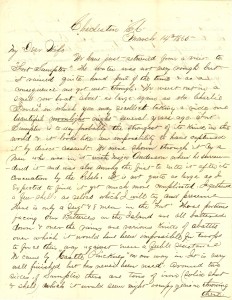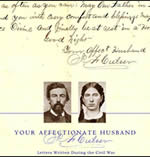 [google-map-v3 width=”400″ height=”300″ zoom=”12″ maptype=”hybrid” mapalign=”right” directionhint=”false” language=”default” poweredby=”false” maptypecontrol=”false” pancontrol=”false” zoomcontrol=”true” scalecontrol=”false” streetviewcontrol=”false” scrollwheelcontrol=”false” addmarkermashupbubble=”false” addmarkerlist=”32.78115; -79.931604{}1-default.png” bubbleautopan=”true” showbike=”false” showtraffic=”false” showpanoramio=”false”]
[google-map-v3 width=”400″ height=”300″ zoom=”12″ maptype=”hybrid” mapalign=”right” directionhint=”false” language=”default” poweredby=”false” maptypecontrol=”false” pancontrol=”false” zoomcontrol=”true” scalecontrol=”false” streetviewcontrol=”false” scrollwheelcontrol=”false” addmarkermashupbubble=”false” addmarkerlist=”32.78115; -79.931604{}1-default.png” bubbleautopan=”true” showbike=”false” showtraffic=”false” showpanoramio=”false”]
Charleston, S.C. March 14, 1865
My Dear Wife
We have just returned from a visit to “Fort Sumpter.” The water was not very rough, but it rained quite hard part of the time, & as a consequence we got wet through. We went out in a small rowboat, about as large again as old Charlie Jones’s in which you may recollect taking a ride one beautiful moonlight night several years ago.1
“Fort Sumpter” is to-day probably the strongest of its kind in the world, & it looks like an impossibility to have captured it by direct assault.2 We were shown through it by a man who was in it with Major Anderson when he surrendered it, and was also among the first to enter it after its evacuation by the Rebels.3 It is not quite as large as I expected to find it, yet much more complicated. I gathered a few shells as relics which I will try and preserve. There is only a sergt. & 8 men in the “Fort”. Those portions [of Fort Sumter] facing our Batteries on the Island [Morris] are all battered down, & over the ruins are various kinds of abattis, over which it would have been impossible for troops to force their way against even a feeble resistance. We came by “Castle Pinckney” on our way in;4 it is very well finished but has never been used. Around two sides of Sumpter there are tons of iron (solid shot & shell) which it would seem might occupy years in throwing there.
I will enclose in this some papers that I should have left at home. The two receipts put in the drawer with my other recpts, & the license in an envelope marked “Licenses.” I think it probable we will try & get to Hilton Head to-morrow, & from there to Wilmington.
We received the New York Herald & Tribune yesterday but there is but little news. We have no news here, and it is as dull as you can possibly imagine. I can scarcely expect to hear from you if we leave here before the next mail arrives, but I shall hope that you are all well and happy.
May God bless you. It is wet & gloomy this afternoon. Remember me in love to all our Friends. Kiss Howard for me.
Good Bye.
Your affect. Husband
J. F. Culver
- Charles Jones was a prosperous Livingston County farmer. [↩]
- Fort Sumter had been attacked by Union ironclads on April 7, 1863. Repulsed with the loss of one vessel, the Federals retired. They returned that summer, and, having secured possession of Morris Island, opened fire on the morning of August 17 on Fort Sumter with all their batteries. A number of ironclads at periodic intervals joined in the bombardment. The masonry walls were pounded into ruins at a number of points, but the Confederate defenders burrowed into the rubble. On the night of Sept. 8, 1863, the Rebels repulsed a landing party. The bombardment was resumed, but failed to dislodge the defenders who remained in possession of Fort Sumter until the night of February 17, 1865, when Charleston was evacuated. D. Ammen, The Atlantic Coast (New York, 1883), pp. 91-110, 130-156. [↩]
- Maj. Robert Anderson on April 13, 1861, had surrendered Fort Sumter to Confederate authorities after a 34-hour bombardment. This event was the point of no return on the road to the Civil War. On April 14, 1865, Anderson, now a brigadier general, returned to Fort Sumter to raise the same United States flag that he had lowered four years before. Warner, Generals in Blue, pp. 7-8. [↩]
- Castle Pinckney was a masonry fort guarding the entrance to Cooper River. Situated as it was in the inner harbor, it had not been subjected to bombardment as had Forts Sumter, Moultrie, and Johnson, and the defenses of Sullivan’s and James Islands. [↩]

 Subscribe via RSS
Subscribe via RSS Subscribe via Email
Subscribe via Email